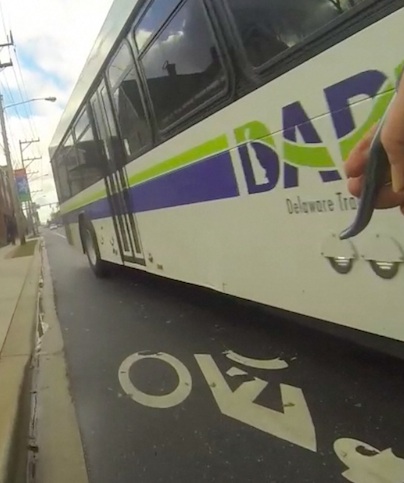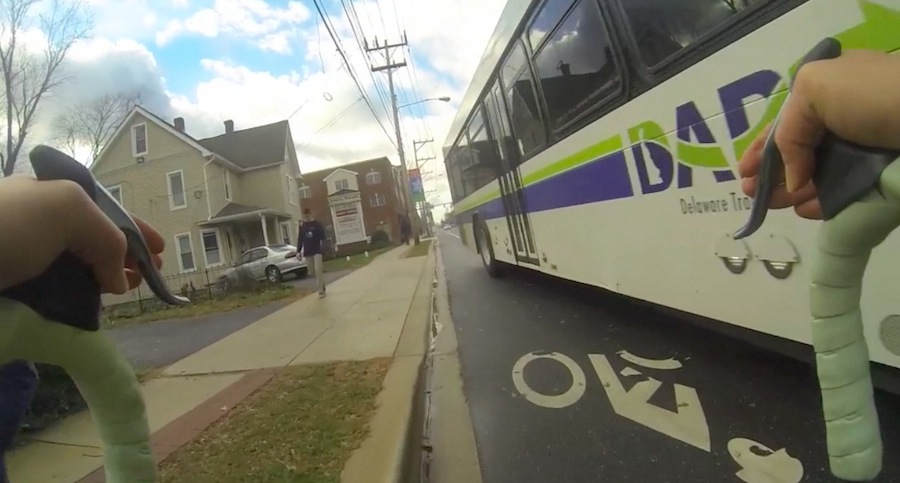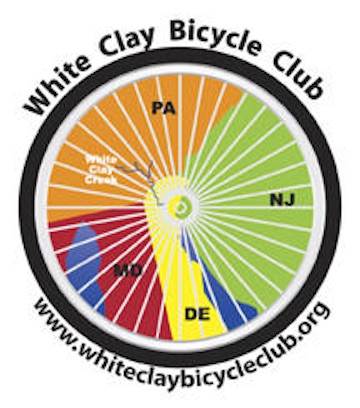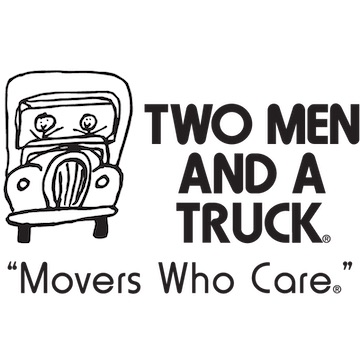UD Grad Student’s Video Highlights Need for Cycle Track in Newark


An exciting encounter with a bus while cycling on Delaware Avenue in Newark.
By Josh Shannon
Published in the Newark Post
Kirsten Jones is no stranger to the perilous Delaware Avenue bicycle lane.
The University of Delaware graduate student uses her bike as her primary means of travel around Newark and estimates she treks down Delaware Avenue at least five times a week.
In her daily travels on the road, she’s learned to be ready for anything: pedestrians stepping out into the street, cars abruptly turning in front of her, buses pulled over in her path and cars parked in the bike lane in front of Newark High School.
“Those are pretty standard experiences,” Jones said, noting that she knows several cyclists who have been in accidents on Delaware Avenue.
Recently, Jones strapped a camera on her bike to create a video documenting the obstacles cyclists face on Newark’s main west-to-east route. It was part of a study Jones did looking at the feasibility of building a two-way cycle track on Delaware Avenue.
Jones, a student in UD’s Institute for Public Administration, produced the report at the request of Newark’s planning department, which has been considering the idea for several years.
A cycle track is a protected bike lane within the roadway but physically separated from motor vehicle traffic by a median or other barrier. It is a key component of the Newark Bicycle Plan, which was adopted by city council last year.
Such a feature would create a safe, two-way route through the city. Many people cycle the wrong way on Delaware Avenue, adding to the dangerous conditions.
Main Street, which of course is used by cars headed west, does not have a bike lane. Though it has “sharrows” – markings on the pavement meant to remind motorists to share the lane with cyclists – navigating the busy road isn’t for the faint of heart, Jones said.
“You have to be pretty confident to jump in the road and bike with the sharrows,” she said.
Instead, many cyclists headed west choose to illegally go the wrong way on Delaware Avenue.
City planner Michael Fortner said Newark is working with the Delaware Department of Transportation, which maintains Delaware Avenue, to move forward with the project, which he said is a “top priority” for the city. DelDOT would pay to install the track, but the city has agreed to maintain it.
“DelDOT wants to do it; it just needs to get in their pipeline,” Fortner said, adding that he hopes to have it done within four years.
He said building the two-lane cycle track would require slightly reducing the width of the vehicular lanes. Engineers haven’t yet determined how the track would be separated from other traffic, but it would probably vary based on the width of the particular segment of road. Some areas could have curbs, while others would likely have thin, reflective bollards.
Jones’ study looked at several ways to construct a cycle track and found that one of the best ways would be to build it on the left side of the road, rather than the right side where most bike lanes are.
Doing so would avoid many of the common obstacles, such as traffic turning right, parked cars and buses pulling over to pick up passengers. It would also mean that the cyclists closest to traffic would be going the same direction as the cars, which is safer.
Another alternative would be to detour the cycle track through a fire lane and up Haines Street to avoid the particularly dangerous intersection of Delaware Avenue and South Chapel Street.
James Wilson, executive director of the advocacy group Bike Delaware, said he hopes Jones’ report and video raise awareness of the need for a safer cycling option through Newark.
“It’s terrifying,” he said. “Just riding across Newark, it seemed like she almost died like three times.”
He said Delaware Avenue is an area of frequent concern for local cyclists.
“There’s a great demand to bicycle west in Newark,” Wilson said.
More than 50 towns in the United States – including Jones’ hometown of Madison, Wis. – have installed cycle tracks and most have seen an increase in bicycling, Wilson said.
“When you create them, it brings cyclists out of the woodwork because you made it less scary,” he said.
RELATED:
• The Time Is Now For Delaware’s 1st Protected Bike Lane
• Newark City Council Discusses a Protected Bike Lane for Delaware Avenue
• The most important committee for bicycling you’ve probably never heard of









6 Responses
The only thing a bike advocacy group should ever say about riding against traffic on a one-way street is “don’t do it, ever.” Instead, Bike Delaware provides a video manual showing what to watch out for when somebody decides the law doesn’t apply to them. Complaining about hazards encountered while riding the wrong direction is *almost* as stupid as actually riding the wrong direction.
Tom, thank you for your comments.
Here is something else we can say about contraflow riding on Delaware Avenue: It happens. It happens A LOT. In fact, the counts say that 30% of ALL cycling on Delaware Avenue is going west, against the direction of motor vehicle traffic. 1 in 3 cyclists!
As the video shows, riding west on Delaware Avenue can be quite terrifying. It is surprising how many people do it, despite how scary it is. (I personally have never ridden west on Delaware Avenue.) But the fact that so many people do it anyway tells us something important: there is a lot of demand to cycle west in Newark on Delaware Avenue. And the fact that we have made Delaware Avenue a 1-way road may be fine for motor vehicles…but it is NOT fine for cycling.
One possible approach to the issue of all that “bad” cycling on Delaware Avenue is to demand that the Newark Police get out there and issue hundreds of tickets. (Let’s “crack down” on lawbreaking cyclists.) But Bike Delaware does not favor an “enforcement” strategy on Delaware Avenue in Newark. We think, in fact, that an “enforcement” strategy is absurd. Instead, we strongly endorse reconfiguring Delaware Avenue to permit two-way cycling. And let’s stop thinking about Delaware Avenue as a one-way road. Instead, let’s think of it as a two-way street…where cars and trucks, however, are restricted and can only travel in one direction.
So it turns out that there is a lot more we can say than “don’t do it, ever.”
James
A two-way bicycle track on Delaware Avenue with exploration of other alternatives as well (rerouting along fire lanes, etc.) sounds great. Cycling has increased on campus in recent years and infrastructure that reflects and supports this shift is welcome. Two notes on the video: 1) cyclists yield to presidents entering crosswalks! 2) Ugh, a police cruiser blocking the cycling lane!
WOW! She almost died three times because she and others don’t know how to ride a bike! You might think all those Dutch, Danes, and Germans instinctively know how to ride their bike in their cycletracks but they are also taught from an early age in formal classes how to ride safely.
The problem with Newark are the one-way couplets that turn what should be slightly congested two-way streets into sewer pipes for auto traffic and a very forgettable downtown. Highway traffic engineering has no place in urban environments!
[…] traffic signals defined and enabled as an engineering tool for DelDOT (specifically enables the Delaware Avenue Separated Bikeway in Newark). Most serious bicycle crashes occur at intersections. There is no more important safety […]
[…] signals defined and enabled as an engineering tool for DelDOT (specifically enables the Delaware Avenue Separated Bikeway in Newark). Most serious bicycle crashes occur at intersections. There is no more important safety […]